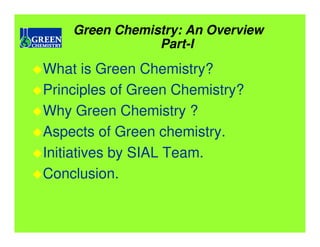
Hiren Ppt Green Chem
- 1. Green Chemistry: An Overview Part-I What is Green Chemistry? Principles of Green Chemistry? Why Green Chemistry ? Aspects of Green chemistry. Initiatives by SIAL Team. Conclusion.
- 2. What is green chemistry ? DEFINITION Green Chemistry is the utilisation of a set of principles that reduces or eliminates the use or generation of hazardous substances in the design, manufacture and application of chemical product GREEN CHEMISTRY IS ABOUT • Waste Minimisation at Source • Use of Catalysts in place of Reagents • Using Non-Toxic Reagents • Use of Renewable Resources • Improved Atom Efficiency • Use of Solvent Free or Recyclable Environmentally Benign Solvent system Green Chemistry Theory & Practice, P T Anastas & J C Warner, Oxford University Press 1998
- 3. The 12 Principles of Green Chemistry (1-6) 1. Prevention It is better to prevent waste than to treat or clean up waste after it has been created. 2. Atom Economy Synthetic methods should be designed to maximise the incorporation of all materials used in the process into the final product. 3. Less Hazardous Chemical Synthesis Wherever practicable, synthetic methods should be designed to use and generate substances that possess little or no toxicity to people or the environment. 4. Designing Safer Chemicals Chemical products should be designed to effect their desired function while minimising their toxicity. 5. Safer Solvents and Auxiliaries The use of auxiliary substances (e.g., solvents or separation agents) should be made unnecessary whenever possible and innocuous when used. 6. Design for Energy Efficiency Energy requirements of chemical processes should be recognised for their environmental and economic impacts and should be minimised. If possible, synthetic methods should be conducted at ambient temperature and pressure.
- 4. The 12 Principles of Green Chemistry (7-12) 7.Use of Renewable Feedstock A raw material or feedstock should be renewable rather than depleting whenever technically and economically practicable. 8.Reduce Derivatives Unnecessary derivatization (use of blocking groups, protection/ deprotection, temporary modification of physical/chemical processes) should be minimized or avoided if possible, because such steps require additional reagents and can generate waste. 9.Catalysis Catalytic reagents (as selective as possible) are superior to stoichiometric reagents. 10.Design for Degradation Chemical products should be designed so that at the end of their function they break down into innocuous degradation products and do not persist in the environment. 11.Real-time analysis for Pollution Prevention Analytical methodologies need to be further developed to allow for real-time, in-process monitoring and control prior to the formation of hazardous substances. 12.Inherently Safer Chemistry for Accident Prevention Substances and the form of a substance used in a chemical process should be chosen to minimize the potential for chemical accidents, including releases, explosions, and fires.
- 5. Waste and The Chemical Industry Where does the waste come from? Industry Segment TONNAGE E factor Oil Refining 106 - 108 <0.1 Bulk Chemicals 104 - 106 1-5 Fine Chemicals 102 - 104 5 - 50 Pharmaceuticals 10 - 103 25 - 100+ • Areas traditionally thought of as being dirty (oil refining & bulk chemical production) are relatively clean - they need to be since margins per Kg are low. • Newer industries with higher profit margins and employing more complex chemistry produce much more waste relatively. E factors (kg waste per kg product) R A Sheldon J Chem Tech Biotechnol 1997 68 381
- 6. Why green Chemistry ?
- 7. Green Chemistry Is About... Waste Materials Hazard Risk Energy Environmental Impact COST
- 8. Pollution Prevention Hierarchy Prevention & Reduction Recycling & Reuse Treatment Disposal
- 9. Some Aspects of Green Chemistry Safer Reactions Catalysis & Reagents Solvent Replacement Separation Processes Green Use of Chemistry Renewable Energy Feedstocks Efficiency Waste Process Minimisation Intensification
- 10. Bhopal Tragedy - A Lesson in Inherent Safe Design CH3NH2 + COCl2 CH3NCO OH Union Carbide India, Limited (UCIL) OCONHCH3 PROCESS OH CH3NH2 OCOCl + COCl2 ALTERNATIVE ROUTE
- 11. Green chemistry Encounters during Process R&D Old Process:- 2-Methylbenzofuran
- 12. New Improved Process New Method for production of dihydrobenzofuran in single step procedure:- The reaction of a variety of 2-ally phenols with iodine in water produced the corresponding 2- iodomethyl-2,3-dihydrobenzofuran in the absence of any additives or organic solvents.
- 13. Am-Ex-OL NH2 O Cl O Pyridine/ KOH,EtOH N O NMP N H O NH NH2 RT NH2 Reflux MW= 136.2 O MW= 240.3 MW= 222.2 N PCl5,POCl3 N NH N 90-100'C O Cl DIOxane MW= 222.2 MW= 240.7
- 14. A Greener way to Am-Ex-OL NH2 O O N NaHSO3 NH2 DMAc/DMF NH MW= 136.2 O MW= 222.2
- 15. The Learning Points: The Principles of Green Chemistry can be applied to the whole of chemistry Think laterally - try the green alternative Consider waste, toxicity & energy as well as yield & purity ‘Sell’ to industry on economic and environmental grounds KISS Green chemistry Not a solution to all environmental problems But the most fundamental approach to preventing pollution.
